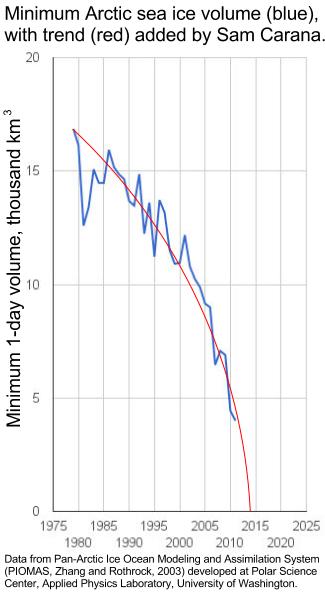Arctic sea ice volumes keep falling. The image below is from the Polar Science Center's Pan-Arctic Ice Ocean Modeling and Assimilation System (PIOMAS, Zhang and Rothrock, 2003).
As shown on the image below, by Wipneus and earlier published at the Arctic Sea Ice Blog, sea ice volume is on track to reach a minimum of 3000 cubic kilometers this summer.
The recent sea ice volume is in line with the exponential trend calculated by Wipneus that is pointing at zero ice volume around 2015 (image below).

As described earlier, I believe that a trendline pointing at 2014 fits the data best (image left).
While some ice may persist close to Greenland for a few years more, this applies only to a relatively small area; this does not revert the curve downwards as it applies to the remainder of the Arctic Ocean. Moreover, there is robust evidence that global warming will increase the intensity of extreme weather events, so more heavy winds and more intense storms can be expected to increasingly break up the remaining sea ice in future, driving the smaller parts out of the Arctic Ocean more easily.
Apart from the albedo change that comes with this loss of sea ice, there's also the loss of snow cover on land. Snow cover over Northern Hemisphere lands retreated rapidly in May and June, leaving the Arctic Ocean coastline nearly snow free, says the National Snow & Ice Data Center (NSIDC), adding that this rapid and early retreat of snow cover exposes large, darker underlying surfaces to the sun early in the season, fostering higher air temperatures and warmer soils.
While some ice may persist close to Greenland for a few years more, this applies only to a relatively small area; this does not revert the curve downwards as it applies to the remainder of the Arctic Ocean. Moreover, there is robust evidence that global warming will increase the intensity of extreme weather events, so more heavy winds and more intense storms can be expected to increasingly break up the remaining sea ice in future, driving the smaller parts out of the Arctic Ocean more easily.
Apart from the albedo change that comes with this loss of sea ice, there's also the loss of snow cover on land. Snow cover over Northern Hemisphere lands retreated rapidly in May and June, leaving the Arctic Ocean coastline nearly snow free, says the National Snow & Ice Data Center (NSIDC), adding that this rapid and early retreat of snow cover exposes large, darker underlying surfaces to the sun early in the season, fostering higher air temperatures and warmer soils.
The NSIDC illustrates this with the edited Rutgers University Global Snow Lab image below.
Another image from Rutgers University Global Snow Lab, shown below, illustrates the anomalies in snow cover on Northern Hemisphere lands over the years.
The joint impact of loss of sea ice and loss of snow cover on land will make a huge difference; much more sunlight is now absorbed, instead of reflected back as was previously the case.
Below are calculations by Professor Peter Wadhams, University of Cambridge. Earth has a total surface area of 510,072,000 square km (196,888,000 square miles), as the table below shows, by Michael Pidwirny, or about 510 million square km.
Professor Wadhams estimates the present summer area of sea ice at 4 million square km, with a summer albedo of about 0.60 (surface covered with melt pools). When the sea ice disappears, this is replaced by open water with an albedo of about 0.10. This will reduce the albedo of a fraction 4/510 of the earth's surface by an amount 0.50. The average albedo of Earth at present is about 0.29. So, the disappearance of summer ice will reduce the global average albedo by 0.0039, which is about 1.35% relative to its present value.
Below are calculations by Professor Peter Wadhams, University of Cambridge. Earth has a total surface area of 510,072,000 square km (196,888,000 square miles), as the table below shows, by Michael Pidwirny, or about 510 million square km.
Surface | Percent of Earth’s Total Surface Area | Area Square Kilometers | Area Square Miles |
Earth’s Surface Area Covered by Land | 29.2% | 148,940,000 | 57,491,000 |
Earth’s Surface Area Covered by Water | 70.8% | 361,132,000 | 139,397,000 |
Pacific Ocean | 30.5% | 155,557,000 | 60,045,000 |
Atlantic Ocean | 20.8% | 76,762,000 | 29,630,000 |
Indian Ocean | 14.4% | 68,556,000 | 26,463,000 |
Southern Ocean | 4.0% | 20,327,000 | 7,846,000 |
Arctic Ocean | 2.8% | 14,056,000 | 5,426,000 |
As NASA describes, a drop of as little as 0.01 in Earth’s albedo would have a major warming influence on climate—roughly equal to the effect of doubling the amount of carbon dioxide in the atmosphere, which would cause Earth to retain an additional 3.4 watts of energy for every square meter of surface area.
Based on these figures, Professor Wadhams concludes that a drop in albedo of 0.0039 is equivalent to a 1.3 W/sq m increase in radiative forcing globally.
The albedo change resulting from the snowline retreat on land is similarly large, so the combined impact could be well over 2 W/sq m. By comparison, this would more than double the net 1.6 W/sq m radiative forcing resulting from the emissions caused by all people of the world (see IPCC image below). Professor Wadhams adds: "Remember that this is going to happen in only about 3 years if the predictions of alarmist glaciologists like myself are correct".
References:
- PIOMAS, Washington University, Polar Science Center
- National Snow & Ice Data Center (NSIDC), July 5, 2012, Rapid sea ice retreat in June
- Rutgers University, Global Snow Lab
- Wikipedia, Earth
- NASA Earth Observatory, May 10, 2005, Earth's Albedo in Decline
- IPCC, Working Group I, Fourth Assessment Report, Summary for Policymakers
- Pidwirny, M. (2006). "Introduction to the Oceans". Fundamentals of Physical Geography, 2nd Edition.





